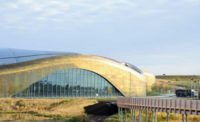Ancient Metal Revitalizes Important Structures
Architects and Specifiers Continue to Select Copper for its Reliability, Adaptability, Sustainability and Longevity
















Some may call copper an ancient material, but architects, installers and specifiers are finding it hard to argue with its adaptability, sustainability and longevity. Mankind’s oldest metal has protected the roofs of cathedrals, state buildings, libraries and homes all over the world for centuries. When properly installed, a copper roof can last more than 100 years. However, long-term performance can be compromised if the roofing system is not designed or installed correctly. Recently, the Copper Development Association (CDA) recognized architects and contractors for their restoration work to rectify such design failures on buildings in the U.S. and Canada.
All metals expand when heated and contract when cooled. While this process is well understood, far too many contractors ignore thermal movement during system design or installation, which can lead to failure of the roofing and flashing system, causing damage to the building. The following four structures were built before the turn of the century—significant design and installation practices have evolved since. While restoration work has been done to these structures over the years, complete roof replacements were needed to improve their structural integrity.
Harvard Law School Langdell Hall
Located in the heart of Harvard Law School’s campus and adjacent to Cambridge’s historic district in Massachusetts, the Harvard Law School Langdell Hall was originally built in 1907 and is home to the world’s largest academic law library in the world, containing more than 2.3 million volumes on 14 miles of shelves. Although work has been done since the original roof installation, the building required extensive repairs to address water damage and leakage that occurred over the years due to cracked mortar and inadequate drainage.
In 2015, nearly 25,000 pounds of copper was used to preserve Langdell Hall to its original appearance and to retain the integrity of the building’s historical character. The roof restoration included replacement of multiple types of roofing systems, including built-up, metal standing seam and PVC membrane and significant parapet flashing. Both standing seam and flat seam copper panels were installed to replace existing copper panels and maintain historical integrity of the original design. Before the copper panels could be installed, extensive masonry repairs were completed on the head houses. New copper panels varied in lengths from 19 feet and 5 inches to 9 feet and 10 inches, 20-ounce per-square-foot. Standing seam height was 1½-inch, with 20 3/4-inch panel width (standing seam to standing seam) with exposed mill finish.
The roof replacement at Langdell Hall revitalized this iconic neoclassical building, named for Harvard’s first Dean of the Law School, Christopher Columbus Langdell.
USNA Maury Hall
Also built in 1907, and designed by Ernest Flagg, the United States Naval Academy’s Maury Hall in Annapolis, Md. recently underwent a complete roofing system replacement. Copper was chosen as the replacement material to match the original upper roof, built in gutter, flashings and ornamental features. It was also selected for its durability; the original copper roof lasted over 100 years. Additionally, the aesthetic of the natural copper is in keeping with the majority of the buildings on the United States Naval Academy campus. Flagg, who designed many of the buildings at the Academy, was largely influenced by his studies at Ecole de Beaux-Arts in Paris. Examples of Flagg’s Beaux-Arts influence can be found in the decorative copper adorning the built-in-gutter on building designs.
The complete roof replacement included an upper double lock standing seam copper roof system, bullnose copper cornice transition, a slate mansard, 34 dormers with double lock standing seam copper and fascia metal, eight copper hip metal caps and a continuous built-in gutter with decorative copper fascia. In total, over 43,000 pounds of 20-ounce copper was used on the project.
The upper standing seam roof was removed and replaced with 24-inch wide 20-ounce copper coil roll formed into 1-inch high by 21 inches wide continuous standing seam panels that matched the original profile. The eave bullnose, which also served as the mansard flashing, was removed and replicated to match the exact size and profile. The 34 dormer roofs were replaced with 20-inch wide 20-ounce copper coil formed into 1-inch high by 17 inches wide continuous standing seam panels. The decorative ornate fascia of the dormers was also carefully removed and used as a template to develop the new two piece copper cornice to which the roof panels locked. The cheeks sides and face of the dormers were also re-clad with custom fabricated copper. The oversized built-in-gutter at the base of the slate mansard was removed and replaced with a new copper liner custom formed and soldered on-site.
The replacement included a specialty bull-nosed drip edge at the base of the slate and an ornate, custom-formed fascia on the exterior of the built in gutter. The decorative copper fascia included 85 hubcaps, 152 half wheels and 14 decorative pressed-copper miters. The original hubcap and half wheel ornaments were broken down and patterns were replicated. Each ornamental piece was hand assembled from a pattern of 14 individual pieces of 20-ounce copper before being installed, at their precise original location, on the new fascia. The miters were made by six different molds, taken from the original worn pieces, in order to stamp the design into the sheet copper.
Designers hope that the new roofing system will last another 100 years, which is entirely reasonably for a properly designed and installed copper assembly. One of the reasons for copper’s longevity is the natural patina it develops over time that serves as a protective layer when the metal is exposed to the elements. Unlike rust oxidation, the copper patina is a protective barrier that inhibits further corrosion, to maintain copper’s long life. The shiny copper installed on Maury Hall will quickly take on a warm brown patina due to the building’s proximity to Chesapeake Bay. Over time, the copper will take on the familiar green patina of the other historic buildings on the site.
The Currie and Mackenzie Buildings, the Royal Military College
Originally constructed in 1918 (Currie Building) and 1876 (Mackenzie Building), the two buildings on the campus of the Royal Military College in Kingston, Ontario, are recognized as significant heritage buildings in Canada. In 2013, a restoration team conducted a detailed investigation of the roofs and their structural detailing using a lift to get an up-close view of the structures. They found that both buildings were in need of new copper roofing systems due to age, weathering and poor original installation methods. The integrated cornice gutter began failing, causing decay in the roof structure.
The copper detailing on both buildings were carefully studied, replicated where appropriate and improved at locations where issues of expansion or failure were apparent. The structures were re-designed for proper function while allowing for thermal expansion. The overall multi-roof project encompassed many different copper roofing types, including batten seam, interlocking small pan, standing seam, soldered flat seam and barrel roofs. The heritage consultant designed a unique system of interlocking flat seam small pans in order to improve both the aesthetic and performance of the mansard roofs on the Mackenzie building. The small pans on the mansard hips resolved in hip rolls, a reintroduced detail from the original construction. Finally, an unsightly roof-level stucco addition, added in recent decades, was clad in seamed small pans to blend in with the historical mansard.
Although the upfront cost of the material can be higher than other roofing materials, copper will prove to be a great choice in the long run. Generally, any higher initial costs for copper applications typically are offset by low to no maintenance costs over the operational life of the building. When properly designed and installed, a copper roof provides an economical, reliable, long-term roofing solution. Its low life cycle costs are attributable to the low maintenance, long life and salvage value of copper. Unlike many other metal roofing materials, copper requires no painting or other finish treatments.
Parkland Hall
Recently, the design team of Parkland Hall on the Old Parkland campus located in the heart of Dallas, Texas specified copper for its aesthetics, longevity and sustainability. With its massive copper dome built in 2015, Parkland Hall is the landmark of what is considered the most exclusive office park in Dallas. Old Parkland sits on 9.5-acres and comprises nine buildings with plans for expansion. It’s named for the hospital that has occupied the property since 1894. Parkland Hall’s signature feature is its domed copper rotunda designed in the Jeffersonian style to complement the campus’ original historical buildings. Its central location on the Old Parkland campus highlights and complements its historical surroundings and provides a new signature landmark for the Dallas skyline.
Parkland Hall architects drew their inspiration from history, modeling Parkland Hall after the Rotunda at the University of Virginia, designed by Thomas Jefferson. Like the Rotunda, Parkland Hall is crowned by a massive copper dome. The ductility and malleability of copper make it an easy material to form over irregular roof structures. Domes and other curved roof shapes are readily handled with copper.
The 96 1/2-foot dome consists of more than 3,000 interlocking (rauten) copper tiles, in 32 rows of diminishing sizes from base to crown. The largest copper tiles are 36 1/4 inches high by 32 inches wide, and the smallest are 44 inches high by 9/27 inches wide. For low-pitch areas at the base and crown, and for the cupola that forms the base of the finial, the copper was fabricated and installed as a double-lock standing seam wall system. Flat-seam wall panels were installed at the base of the dome and finial. The more than 300 feet of inlaid radius gutter was fabricated in 8 feet lengths, with each length consisting of four sections seamed and soldered. The dome is intersected by eight rib rolls, each anchored by a decorative base scroll. The eight rib rolls were fabricated in 19 sections (27 inches high by 30 inches wide by 39 inches long), each consisting of five elements with concave and convex detail. Each of the eight base scrolls are 66 inches high by 48 inches wide.
All of the projects mentioned above were recognized as winners of the North American Copper in Architecture (NACIA) awards program. Since 2008, the CDA and the Canadian Copper Brass Development Association have recognized outstanding copper and copper alloys building projects in North America. The awards program, which is celebrating its 10th anniversary in 2017, showcases a wide range of building projects, all of which highlight craftsmanship, attention to detail and architectural vision.
For more information about the copper restoration work and the different types of copper applications, reference the Copper in Architecture – Design Handbook. To view past recipients of the NACIA award program, visit CDA’s website at www.copper.org.
Looking for a reprint of this article?
From high-res PDFs to custom plaques, order your copy today!













